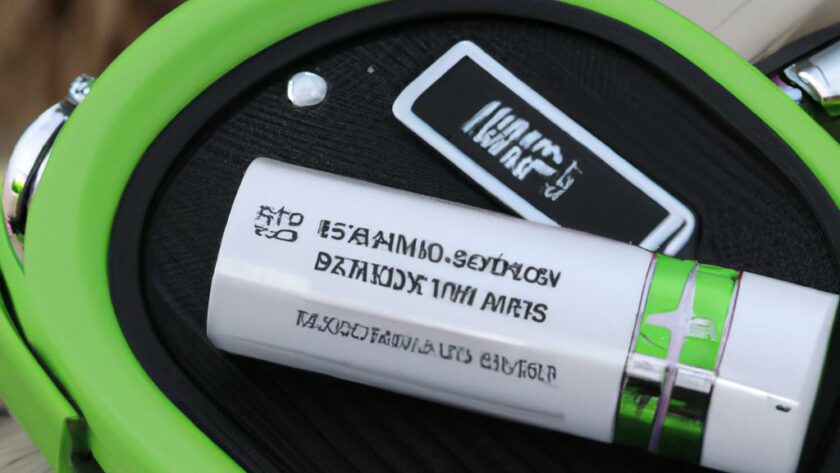Why Should You Be Concerned About Leaving the Battery in Your eBike?
If you’re a proud owner of an eBike, it’s essential to understand how to take proper care of your electric bike’s battery. One key aspect is knowing whether you can leave your battery in the bike when not in use, especially if you need to store it for an extended period.
You may be tempted to leave your battery in the eBike all the time as you don’t want to go through the hassle of taking it out. However, leaving the battery connected to your electric bike when not in use can compromise its lifespan and potentially cause safety hazards.
- Protecting the Longevity of the Battery: One concern associated with leaving your battery in your eBike is preserving its overall lifespan. The more you use your bike, the quicker the battery levels will decrease even when left stationary. Thus, prolonged periods of inactivity mean that the battery risks permanently losing its maximum charge holding capabilities.
- Safety Considerations: Leaving your battery connected to your eBike when not in use without ensuring its being stored securely can pose safety risks due to possible combustion or other electrical problems that can damage the bike itself-
Hence, it’s absolutely important that you look into how best to maintain and protect your battery when leaving it in your eBike.
Why Are People Concerned About Leaving Batteries in eBikes?
If you recently invested in an eBike, you may want to know if it’s safe to leave the battery in when you’re not using it. Many people have concerns about the lifespan of their battery and want to make sure it stays in good condition over time.
The primary reason for worry is that leaving a battery in your eBike can cause it to deteriorate faster or even sustain damage. Certain factors such as extreme temperatures and overcharging the battery can shorten its lifespan. Therefore, any damage related to these causes can potentially result in having to replace the battery earlier than expected.
If someone has gone through the trouble and expense of purchasing an eBike, it only makes sense to ensure that this asset remains in excellent condition. The battery serves as a vital part of any eBike as it makes it run efficiently with low carbon emissions. That’s why it’s essential to know how you can store and maintain the battery on your eBike correctly.
Types of Batteries Used in eBikes
There are two main types of batteries used in eBikes: lithium-ion and lead-acid. Each has its own benefits and drawbacks, which should be considered when choosing an eBike:
- Lithium-ion: These batteries are lighter and more compact than lead-acid batteries, making them a popular choice for eBikes. They also offer higher energy densities, meaning they can store more power in a smaller space. However, they can be more expensive than lead-acid batteries. One concern with lithium-ion batteries is that they can lose overall capacity over time if left in an eBike for extended periods without use, but newer models are less susceptible to this issue.
- Lead-acid: These batteries have been used in eBikes for many years and are known for their durability and low cost. They are also typically more resistant to high temperatures than lithium-ion batteries. However, they are heavier and less energy-dense, which means they may not last as long or perform as well as lithium-ion batteries. Additionally, acid can leak out of lead-acid batteries if they are damaged or not properly cared for.
Overall, the choice between lithium-ion and lead-acid batteries will depend on personal preferences and budget. It is important to note, however, that both types of batteries require proper storage and maintenance to ensure their longevity and performance.
Leaving Your Battery in Your eBike
Are you wondering whether it’s okay to leave your battery in your eBike? You’re not alone. Many people are concerned about the lifespan of their battery and potential damage over time. Let’s take a closer look at the impacts of long-term battery usage, specifically with lithium-ion batteries.
If you’re thinking of storing your eBike for an extended period of time, such as over the winter months, it’s best to remove your battery from the bike. Leaving a lithium-ion battery in the eBike for too long can result in a loss of overall capacity, meaning the battery cannot hold as much charge as when new. This wear and tear caused by idleness is known as “self-discharge.”
However, newer lithium-ion batteries are engineered with advanced technology allowing them to be less susceptible to self-discharge compared to older batteries. The problem of losing overall capacity can be less severe if a lithium-ion battery is designed with high-quality materials that cope well with periods of nonuse.
- – If you need to store your eBike for an extended period of time
- – Always first check to see how long your battery is capable of surviving before experiencing any discharge
- – While storing it make sure you are managing the temperatures. Don’t keep the battery exposed to cold or harsh sunlight due to changeable weather. Exposure to moisture and water, or soiling in any environment should not be avoided whatsoever.
So, if you want to get the most out of your lithium-ion battery’s lifespan, consider removing it from your eBike when storing your bike and always keeping it charged through periods of use as well as non-use.
In case you’ve also forgotten to recharge your battery before storage remember to never let a lithium-ion battery discharge entirely, as that can contribute to decreased capacity. Ensure if possible that the volume percent above charged in diverse potential ways like timing – such is advisable after returning home from a ride, keeping it on an available wireless charger, the use of the semi-permanent flushmount sticking points near the handlebar (on some models), or any other potential automatic repetition of this process.
It’s essential to care for and maintain the function of the batteries. They should not be thrown under the bus, even when complementing their safety and long-lasting storage efficacy, such as going with several proactive but easy protocols: frequent charging makes sure there’s no runout when verifying batteries have their right regulated lifecycle with maximal intent!
Impact of Temperature on eBike Batteries
It’s a well-established fact that the lifespan and performance of eBike batteries are contingent on many factors. One such consideration is temperature, which harbors a significant influence on the overall quality and capacity of eBike batteries.
If eBike batteries are exposed to high or low temperatures, it can have adverse consequences on battery life. Lithium-ion batteries, which are frequently used in eBikes, can encounter a dramatic decrease in efficiency when confronted with temperature extremes. Freezing temperatures impede the flow of ions, impeding the battery’s ability to charge and discharge. Additionally, excessively elevated temperatures (often higher than 60°C) disrupt internal chemistry, accelerating the rate of decay.
One of the critical solutions to eradicating the harmful impact of temperature on eBike batteries is to ensure that they are stored at room temperature. Storing batteries in the range of 20-25°C is optimal and proactively contributes to prolonging its overall lifespan, helping maintain maximum efficiency over time. If you reside in particularly hot or cold regions, aim for temperature-controlled storage methods, ensuring your eBike battery doesn’t suffer the price of improper storage.
Also, avoid exposing your eBike battery to water or other liquids as this can cause a short circuit, thus damaging it. Avoid parking your eBike against cold concrete pads or flooring resists heat flow, removing the battery from the bike entirely, keeping it inside your residence under suitable temperature-controlled conditions may be advantageous if practical.
The goal of effectively managing impacts on batteries’ charges is twofold, to optimize the charging regime to achieve the best performance and longevity and safeguard the battery’s operation against detrimental environmental effects, like extreme occupational temperature categories or humidity levels.
To sum up, high or low temperatures can destroy the efficiency of eBike batteries, leading to premature battery decay. Ensuring that your battery is safeguarded from climate factors necessitates proper temperature-controlled storage. With proper storage techniques and standard charging protocols, you’ll overcome the environmental harm on your eBike batteries.
How to store your eBike battery when not in use
Storing your eBike battery correctly when you’re not using it is essential for maintaining its longevity and ensuring it performs at its best every time you need to use it. Here are some tips:
- Store it at room temperature: Exposure to extreme temperatures can harm your battery’s ability to hold a charge. Stored at room temperature, it maintains the ideal levels of heat and humidity required for optimal performance.
- Avoid water exposure: Keep your battery away from damp or wet environments to prevent damage to internal components, rust, or corrosion.
- Away from direct sunlight: Additionally, make sure your eBike battery is stored away from brightly lit areas and direct sunlight to keep it cooler and reduce the risk of overheating.
- Charge it fully before storing: To keep your battery in good condition, make sure your battery has a full charge before storing it. You should consider using a timer charger if your batteries tend to overcharge.
- Easy access: Finally, consider storing your ebike battery in an easily accessible location to make it easy to install back onto the rested vehicle when needed. Smart storage solutions like wall mounts are handy for keeping your battery will within reach while saving your workbench storage space.
Overall, if you follow these simple storage guidelines, your eBike battery should remain in excellent condition and enjoy a long, functional usage period for years down the road.
Benefits and Drawbacks of Removing the Battery from an eBike
So, you want to extend the lifespan of your eBike battery. One of the biggest decisions is whether or not to remove it entirely when not in use or just leave it on the bike.
The biggest benefit of removing the battery from the eBike is to protect it from theft. A removable battery also means you can charge it easily, even in places where an external power supply isn’t available. Moreover, lightening your eBike by a few pounds can make it more convenient for transport or for carrying up stairs.
The main drawback of this approach is that, over time, it can become a hassle to remove the battery after every ride and then find the right storage. If you don’t have easy access to a power source at home, charging the battery can be challenging and may require a separate trip to a charging station.
- Benefits:
- Protection against theft
- Easier to charge using an external power source
- Bike can be lighter and easier to transport
- Drawbacks:
- May become a hassle to remove the battery after every ride
- Requires separate accession to storage and a recharging power source
To help make this decision easier, consider your daily itinerary and how important this process is for you. If you ride infrequently or only for short distances in low temperatures, you might get along just fine leave the battery on board. But if you ride more often or you live in particularly hot climates, trying to protect your battery outside could make all the difference.
How to Ensure Your eBike Battery is Fully Charged Before Storing It
If you are planning to store your eBike with its battery attached for an extended period of time, it’s important that your battery is fully charged before doing so. This helps to maintain the overall health of your battery and to prevent it from being damaged over time. Here are some tips on how to ensure your eBike battery is fully charged before storing:
- Use a battery charger designed for your eBike’s battery. A charger made by a different manufacturer may not be compatible.
- Make sure the charging port on your eBike is clean and free of dirt or debris that could interfere with the connection of the charger.
- Set a timer to remind yourself to check on the battery’s charge level periodically. This will give you peace of mind and allow you to address any charging issues before storage.
- If your eBike has a battery level indicator, monitor it as the battery charges to ensure it reaches 100%.
Remember, overcharging can cause damage to an eBike battery. Once the battery is fully charged, disconnect it from the charger and turn off the charger to avoid overcharging by mistake. Storing a fully charged battery also helps maintain the overall performance and life of the battery over time.
In conclusion, making sure your eBike battery is fully charged before storing in your bike will keep your battery reliable and healthy. You’ll be able to rest assured that when it comes time to use your eBike once more, the battery will provide ample juice no just right for your needs.
Don’t Neglect Your eBike Battery During Non-Use
If your eBike is going to be sitting for an extended period, it may be tempting to ignore your battery until you’re ready to ride again. However, neglecting your battery can cause issues down the line that may require costly repairs or even a full battery replacement.
Frequent charging during periods of non-use is crucial in maintaining the full capacity and longevity of your battery. Leaving your battery to sit unused for long periods can cause its charge level to drop, resulting in capacity loss over time.
- To avoid capacity loss in lithium-ion batteries, make sure to charge your battery at least once every three months, even if you’re not using it.
- In colder climates, it’s essential to charge your battery more often, as low temperatures can further impact the battery’s performance. Regular charging can help mitigate these issues and provide longer-lasting battery capacity, ensuring you don’t need to replace it anytime soon.
Additionally, before storing your eBike or battery for long periods, ensure your battery is at about 80% charge. This range is optimal for storage, as it balances capacity preservation with preventing battery damage from overcharging. If you’re unsure how to accomplish this, most brands offer on-board charging systems and display screens that let you view your battery’s charge state and optimize your charging frequency accordingly.
Remember that proper care and maintenance of your battery during each stage of use and storage is essential to maintain its quality. Regular charging may also improve your overall riding experience since frequent charging cycles have been observed to condition and soften cells, resulting in better battery life.
How to Properly Dispose of Your eBike Battery
Like any battery, your eBike’s battery will eventually reach the end of its lifespan. It’s important to dispose of it properly to ensure environmental safety and compliance with local regulations.
The first step in disposing of your eBike battery is to determine the type of battery it is. This information can typically be found on the battery itself or in the eBike’s manual. Lead-acid batteries are considered hazardous waste and must be recycled. Lithium-ion batteries are also recyclable, but they don’t pose the same environmental risks as lead-acid batteries.
- Contact your eBike manufacturer or local recycling center to determine the appropriate disposal method for your battery.
- Keep in mind that some retailers may offer take-back programs or credits for old batteries.
- Never dispose of your battery in the trash or landfill. This can lead to hazardous chemicals leaching into the soil and polluting water sources.
To prepare your battery for disposal, determine if it still has any charge remaining. If it does, discharge the battery by placing it in a ventilated area and using an LED light or other low-power device until the battery is completely drained.
Once the battery is fully discharged, remove it from the eBike and store it in a cool, dry place free from moisture and flammable materials. Wrap it securely in unprinted newspaper or bubble wrap to prevent accidental electrical discharge.
In conclusion, while it can be tempting to simply toss out an old battery, proper disposal is necessary to reduce environmental impact. Contact your local recycling center or retailer for specific disposal instructions, and take care to store and transport your old battery safely. Doing so will not only protect the environment but also maintain safety for those who handle the battery during the disposal process.
Charging Habits and Your Battery Life
One thing that can significantly impact the lifespan and overall performance of your eBike battery is how you recharge it. Both over-charging or under-charging can lead to problems, so it’s essential to understand proper charging practices to maintain the longevity of your battery.
If your battery typically lasts for 40 miles before needing a recharge, it’s ideal to charge it back up when it’s down to about 20-30% of its overall capacity. It’s best to avoid overcharging your battery by leaving it on the charger longer than necessary; this can significantly reduce the overall lifespan of your battery. On the opposite end of the spectrum, regularly discharging your battery to levels that are lower than recommended can lead to issues like sulfation (a type of damage that occurs when lead-acid batteries discharge)“
- Proper Charging Habits: To ensure proper charging of your eBike battery, consider getting a quality charger that has an automatic stop function to prevent overcharging, run vinegar to batteries keep terminal clean, and charge it frequently but is mindful of low charges.
- Tips for Maintaining Your Battery: Avoid charging your battery until it reaches its complete depletion. Keep in mind that your storage habits combined with how and where you use your E-bike can significantly affect your battery’s performance in the long run.
- Final Thoughts: The type of maintenance strategy that you choose for your eBike battery could make or break its lifespan. Proper charging habits, including avoiding over-charging or sustained charging (leaving it plugged into the electrical power source) after it has fully charged, will significantly help maintain the quality of your battery over time.
Over time, expect your battery to lose some of its overall capacity. Although most lithium-ion batteries have a reasonably long lifespan compared to other batteries, taking proper care of it is essential for augmented mileage and smooth operation. Always remember, each time you charge your battery and store it away correctly, you’re helping to ensure that your eBike performs as it should in the long run.
Conclusion: Leave your battery safely in your eBike!
After reading this guide, you may be wondering, “Can I leave my battery in my eBike?” And the answer is yes, but only if you take proper storage and charging precautions to prevent damaging the battery.
- The concerns about leaving a battery in your eBike are typically related to maintaining its lifespan and preventing damage over time.
- There are different types of batteries commonly used in eBikes, including lithium-ion and lead-acid.
- Leaving a lithium-ion battery in an eBike for extended periods can result in a loss of capacity, but newer lithium-ion batteries are less susceptible to this issue.
- The temperature can also impact batteries, so be sure to store your battery at room temperature and avoid exposure to water or other liquids.
- If you do decide to leave your battery in your eBike, always be sure it is fully charged and make charging your battery during periods of non-use part of your routine.
- If you need to store your battery for an extended period, consider removing it from your eBike and storing it in a dry, cool area. Always periodically check your battery’s charge level to ensure it is not drained or low.
- Finally, disposing of your battery properly is important to prevent environmental harm. Make sure to follow all local regulations and use resources available for proper recycling or disposal.
Ultimately, while leaving a battery in your eBike may be an option, proper care is critical. With the right storage and charging habits, you can maximize the lifespan of your battery and ensure long-lasting and efficient eBike performance.
Frequently Asked Questions about Leaving Battery in eBike:
- Q: Why are people concerned about leaving their battery in an eBike when it’s not in use?
A: These concerns are typically related to maintaining the lifespan of the battery and preventing damage over time. - Q: What are the different types of batteries commonly used in eBikes?
A: The most common are lithium-ion and lead-acid. - Q: Does leaving a lithium-ion battery in an eBike for extended periods of time can affect its overall capacity?
A: Yes, it can result in a loss of overall capacity, but newer lithium-ion batteries are less susceptible to this issue. - Q: How can temperature impact battery performance and lifespan?
A: Extreme heat or cold can have negative effects on battery performance and lifespan. - Q: Should I remove my battery from the eBike when it’s not in use?
A: It depends on your personal needs. There are benefits and drawbacks to removing the battery from the eBike when it’s not in use. - Q: How can I properly dispose of a battery that has reached its end of life?
A: You can recycle or dispose of it in accordance with local regulations. - Q: What should I do to maintain proper charging habits and prolong battery life?
A: Charge frequently during periods of non-use, be mindful of charging habits such as over-charging or under-charging, and ensure that the battery is fully charged before storing it.
comments: 0




